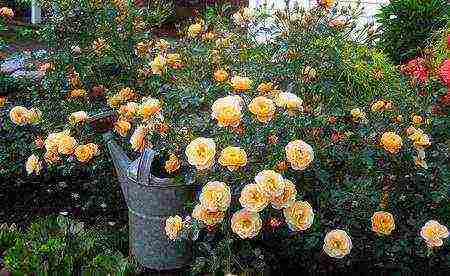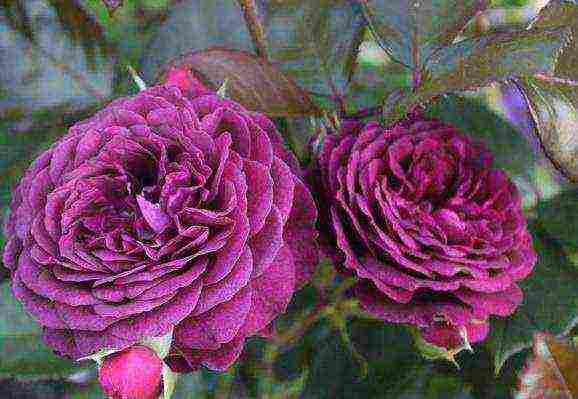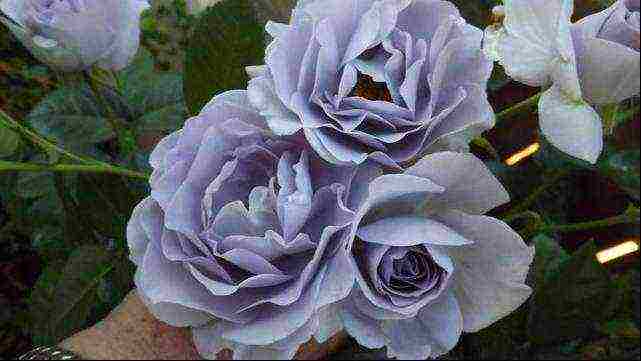Content [show]
Undoubtedly, the mysterious beauties of roses on the site look gorgeous, majestic. There are many types: well-known and real surprise finds. Recently, floribunda roses have become very popular in landscape design. The hybrid was born by crossing muscat, tea and polyanthus roses.
The result is amazing. They bloom magnificently and for a long time (the stages of flowering are waves), they are distinguished by an abundance of colors and high quality flowers. They are resistant to diseases and pests, they winter successfully. It is easy to plant them, they are notable for their unpretentious care: even beginner gardeners can cope with this. It will take a minimum of effort to settle these beautiful plants on your site.
Why grow a floribunda rose

Why is it worth planting a floribunda rose photo of flowers
Depending on the variety, the height of the stem varies from 30 cm to 1 m. The top of the shoot is crowned with a whole bouquet of bright fragrant flowers. Large (the diameter of the corolla is 4-10 cm), cupped or goblet, can be simple or double. Flowering begins in mid-summer and lasts in waves until late autumn, with more and more flowers appearing with each wave. The main advantage of this type of roses is abundant, lush, long flowering. The bushes are just strewn with thick clouds of large roses.
At your discretion, floribunda roses can be grown as a shrub, in a standard way, and even as a pot plant. Thus, they can become a decoration not only for a garden plot, but also for a terrace, veranda, balcony, loggia, apartment, house. In cut, they retain freshness for a long time.
Due to their advantages, floribunda roses are gaining more and more popularity. Perfectly solo, effective in group plantings, will become a colorful accent on the lawn. With ease of planting and maintenance, you will get a gorgeous bloom throughout the season.
How to plant a floribunda rose
Seat selection
Choose your landing site carefully. They need warmth, protection from cold winds and drafts, and bright lighting.
Site preparation
Prepare the site in advance: dig up, clear of debris and weeds. Immediately before planting, dig planting holes with a minimum size of 50 by 50 cm - in tight conditions, the root system does not develop well. The grafting site (root collar) should be 2-3 cm below the soil surface. This will favorably affect the development of additional roots. When planting in a group, about 7 bushes are placed on 1 m² of the plot.
How to plant

How to plant a floribunda rose bush in the ground photo
The holes are prepared in advance, a little freer than the earthen lump of the seedling or its root system. Place the seedlings in the holes. Fill the rest of the space with the following mixture: 2 parts of garden soil, 1 part of peat, humus, sand, 0.5 parts of crushed weathered clay. Add a handful of superphosphate and bone meal. Mix all components thoroughly.

After planting a floribunda rose, mulch the trunk circle photo
Water liberally after planting. To maintain the moisture level, cover the soil surface with humus, grass cuttings or sawdust. This measure will protect against weed germination.
How to plant and care for a floribunda rose, look at the video:
How to care for a floribunda rose
All care procedures are reduced to timely watering, top dressing, pruning and preparation for winter.
How to water properly

How to water floribunda roses
Floribunda roses need abundant and timely watering. When the soil dries out, buds can be discarded. If, after a sultry day, spray the leaves from a fine spray with warm water, the bush will become fresher and more beautiful.
Loosen the soil periodically. Remove weeds from the area.
Top dressing
In gratitude for the careful care, the shrubs will delight with a large number of buds, the flowering period will be long.
Apply top dressing regularly throughout the season. Alternate organic matter (this can be compost, humus, mullein) and mineral fertilizers (urea, saltpeter, potassium).
Floribunda rose pruning
Bushes need rejuvenation and shaping. Pruning is carried out in spring and autumn. For some varieties (Flame of the East, Eslanda Robson, Red Poppy, Danko) - even in summer. This will have a beneficial effect on flowering: 3-4 waves are possible.
The first and main pruning is carried out at the very beginning of the growing season. In summer and autumn, moderate pruning is used: faded flowers and brushes are removed, it is possible together with two extreme buds.
Old branches (over 2 years old) are cut out completely. Shorten the shoots by 4-6 eyes. Also, on the main stem, the lateral processes should be shortened.
Shelter for the winter for a floribunda rose
In the middle zone for the winter, you will need to build a shelter.
Carry out pruning, clear the bush of leaves and inflorescences. Then you should huddle: make a mound about 30 cm high. Sprinkle with fallen leaf or cover with spruce branches, on top - non-woven material. Such a shelter will protect even from the most severe frosts. It must be removed in a timely manner in the spring so that the bushes do not begin to rot and rot. Get rid of the hiding place as soon as the weather is relatively warm.
How to propagate a floribunda rose by cuttings

How to cut a floribunda rose
Floribunda roses are propagated by cuttings or grafted onto rootstocks, but the second method is difficult for beginners, let us consider in more detail only cuttings.
- Cut the cuttings of a rose from lignified shoots.
- The length of the handle should be about 8 cm, the width should be about the size of a pencil.
- Determine the cut location 0.5 cm higher from the kidney.
- Make the upper cut straight, the lower cut at an angle of 45 °.
- It is necessary to remove thorns and leaves from the bottom of the cutting.
- Treat with a growth stimulant to improve rooting.
You can root cuttings outdoors.An interesting way to root cuttings of a rose in a potato: just make a depression in the potato, insert the cuttings and plant like that. The potato will gradually release moisture and nutrients to the cuttings, creating favorable conditions for rooting.

How to plant a floribunda rose stalk in a potato photo
It is better to arrange the cutter so that the midday sun is shaded, and direct rays fall either in the morning or after 16-00 so that the plants do not overheat. The best place is partial shade next to trees or near the walls of buildings, a solid fence. Make holes about 15 cm deep, half-deepen the stalk. Keep a distance of 15-30 cm between the cuttings.
Cover the top with a clear, tight bag or cut-off plastic bottle - create a greenhouse environment. Ventilate periodically. It is necessary to regularly water, loosen the soil.
Shelter is mandatory for the winter: the seedlings are covered with a layer of leaves of 20 cm and covered with lutrasil on top. In the spring, after the snow melts, the shelter is removed as soon as the earth dries up and there is no frost. Feed the seedlings 1-2 times a month with complex preparations.
Young growth in one place is raised for 2 years. When the first buds appear, they are cut off - they interfere with the development of the root system. In the 3rd year, transplant the resulting floribunda rose seedlings to a permanent growth site.
The best varieties of floribunda roses with photos and descriptions
Varietal variety pleases with a wide selection. So that you don't get confused, consider the most popular of them.
White floribunda rose Variety Carte Blanche Carte Blanche rose Floribunda

Floribunda rose Variety Carte Blanche Carte Blanche photo
The height of the bush is about 1 meter. The stem is densely leafy. Flowers are double, medium-sized, snow-white. Lush bloom lasts until autumn. Occasionally it can affect fungal diseases.
Galaxy variety Galaxy rose Floribunda

Rose Floribunda Variety Galaxy Galaxy rose Floribunda photo
The stem reaches a height of 70-80 cm. Throughout the season, flowers appear in pastel yellow tones with a reddish tint at the edges of the petals. They are terry, medium-sized, distinguished by the original aroma of linseed oil.
Rose floribunda Blue Wonder Blue Wonder rose Floribunda

Rose floribunda Variety Blue Wonder Blue Wonder rose Floribunda
It is very often used in foreground plantings. It has a high resistance to diseases and has received many high awards. It is a sprawling bush about 60 cm high. The stem is covered with dark green glossy leaves. Double flowers of medium size, pink-salmon shade are collected in armfuls of inflorescences.
Rose floribunda Blue Bajou Blue Bajou rose Floribunda

Rose floribunda Blue Bajou Blue Bajou rose Floribunda photo
Flowers of an extraordinary blue hue make the variety very popular. A large number of corollas of a lilac-bluish hue appear on the shoots, the yellow core emphasizes the bluish tone. Beauty is worth some capriciousness: it reacts to temperature changes, air humidity, and can be subject to disease.
Rose floribunda Niccolo Paganini Niccolo Paganini rose Floribunda

Floribunda rose variety Niccolo Paganini Niccolo Paganini rose Floribunda photo
It is used most often to decorate the site and make bouquets, has excellent immunity. The appearance is classic: a powerful densely leafy bush, flowers are large, fragrant, dark red.
Rose floribunda Freesia Friesia rose Floribunda

Rose floribunda variety Freesia Friesia rose Floribunda
It blooms the earliest, and at the same time pleases until the very frost. The bushes are compact, dense, about 70 cm high. The flowers are double, bright yellow, which does not fade even under intense exposure to the sun. They exude an extraordinary aroma.
Lili Marlen rose Floribunda variety

Rose floribunda variety Lili Marlene Lili Marlen rose Floribunda photo
It is grown in greenhouses around the world for its trustworthy reputation. The bush reaches a height of 70 cm, covered with glossy green leaves with a bronze sheen.The flowers are medium-sized, semi-double, fiery red in color, have a light aroma.
Rose floribunda pink variety Sangria Sangria rose Floribunda

Floribunda rose cultivar Sangria Sangria rose Floribunda photo
An interesting variety, it can be called a novelty. The color is bright crimson, and the intensity of the shade remains throughout the entire flowering. The flower is two-tiered: the lower rounded petals are 6 cm in diameter, and the inner ones are 3 cm. The latter have pointed tops. The bud is dense. It grows well in almost any conditions, is not susceptible to disease. Rejuvenating pruning will need to be carried out no more than 1 time in 3-5 years.
Rose Stromboli floribunda Stromboli rose Floribunda

Floribunda rose cultivar Stromboli Stromboli rose Floribunda photo
Shrub with upright, strong shoots, reaches a height of 70-80 cm. Leaf plates are dark green, glossy. Flowers are cup-shaped, double, bright red. Rippled petals, velvety. The inflorescence is formed by 3-10 buds. Blooms profusely for a long time. The aroma is light, mild.
Rose floribunda Nina Weibull Nina Weibull rose Floribunda

Floribunda rose red variety Nina Weibul Nina Weibull rose Floribunda photo
The bush is about 60-80 cm high, up to 60 cm wide. Red large double dense flowers are collected in clusters of several pieces, on average 5. The variety is frost-resistant, not susceptible to diseases, easy to care for and blooms profusely throughout the warm period.
Rose floribunda Parrot Pierrot

Rose floribunda Parrot Pierrot rose Floribunda photo
Amazing shades: blooming, the buds have a delicate creamy shade, over time, the petals darken, turning into bright crimson. Flowers are collected in round balls of inflorescences, tightly pressed against each other. Bush up to a meter high.
Floribunda rose Prince of Monaco

Floribunda rose Prince of Monaco Prince de Monaco photo
The peculiarity of the variety is the double color of flowers. Delicate cream petals have a bright crimson edging. Individual roses reach a diameter of 10 cm, dense buds have up to 40 petals, 5-7 flowers are collected in inflorescences. The height of the bush is up to a meter. These roses are good for cutting and as garden flowers. The variety is frost-resistant, almost not susceptible to disease. Flowering is continuous throughout the warm season.
Rose floribunda Kimono Kimono rose Floribunda

Rose floribunda Kimono Kimono rose Floribunda photo variety
The height of the bush of this variety reaches 80-100 cm. The inflorescences contain from 5 to 10-20 large flowers of a delicate salmon shade. High frost resistance, perfect for the middle zone, the Moscow region and the Leningrad region, without requiring shelter for the winter.
Rose Floribunda Flamenco rose Floribunda Flamenco

Rose floribunda Flamenco rose floribunda Flamenco
Delicate pink flowers are double, dense, up to 30 petals, reach about 12 cm in diameter. The variety is resistant to diseases, blooms for a long time and profusely all summer and warm autumn. It is a tall variety reaching 185 cm in height. Keeps freshness for a long time in cut.
Floribunda Rose ‘Iceberg’

Floribunda Rose Iceberg Floribunda Rose ‘Iceberg’ photo
Fantastic variety with dense inflorescences of large double flowers. Flowering is so abundant that it completely covers the bush from base to top and branches are almost invisible. There are varieties with white, purple, pink flowers.

Rose floribunda Burgundy iceberg Burgundy Iceberg Floribunda Rose photo
The height of the Iceberg variety is up to 80 cm, the bushes are compact, spherical. Flowers up to 7 cm in diameter. The variety is frost-resistant. Not susceptible to diseases, including powdery mildew and black spot. The aroma is subtle, but very delicate and pleasant.
Rose Floribunda Gold Memories Golden Memories Floribunda Roses

Rose Floribunda Gold Memories Golden Memories Floribunda Roses
It is impossible to ignore the beautiful yellow rose Floribunda Gold with its luxurious lush inflorescences, large double flowers and rich green leaves. In the sun, the bush looks great, playing with contrasts. The height of the bush is up to 90 cm. It blooms profusely throughout the warm season.
Rose floribunda Laminuette Laminuette rose Floribunda

Rose floribunda Laminuette Laminuette rose Floribunda photo
Mainly grown for cutting, because the beauty of the flowers and the long preservation of freshness are the main advantages of the Laminuette variety.The creamy-sandy center of the bud, as it blooms, is surrounded by darkening petals, which take on a pale pink color with a border around the edge of a more saturated shade.
The variety is magnificent as a garden rose, the flowers do not crumble for a long time and new buds are constantly blooming. Abundant flowering throughout the season. The bush is compact, up to 80 cm tall.
Rose crystal floribunda Crystal Palace rose Floribunda

Rose crystal floribunda Crystal Palace rose Floribunda photo
The Crystal Palace variety has a luxurious appearance: large, 12-14 cm in diameter, creamy apricot flowers are collected in inflorescences, densely covering the bush. The flowers are double, dense, up to 40 petals, the leaves are dark green, with a glossy sheen. Light aroma, bush height 60-80 cm.
Rose floribunda Queen or Queen Elizabeth Queen Elizabeth floribunda Rosa

Rose Floribunda Queen or Queen Elizabeth Queen Elizabeth floribunda Rosa photo
A charming variety with 40-petal goblet inflorescences. In a cluster of inflorescences up to 15 flowers. The bush requires easy pruning, grows up to 180 cm in height. Powerful shoots are not afraid of wind and rain, keeping their neat appearance. Every 5-6 years, a rejuvenating cardinal pruning is required, due to which the rose regains its previous appearance and does not degenerate. Queen Elizabeth is resistant to almost all diseases, sometimes it is affected by rust. The shape of the bush is narrow, erect, thanks to which the rose acquires an exquisite regal appearance. Leaves with a glossy sheen, dense, leathery, rather large, rich green.
Rose floribunda circus Circus Floribunda Rose

Rose Floribunda Circus Lavender Flower Circus Floribunda Rose
The circus series is distinguished by a variety of colors and shapes. There are lavender, salmon red, pink, yellow, blue shades of flowers. The bush is up to 80 cm high, the flowers are large, full, up to 8 cm in diameter. The thorns are large and few in number, the variety is resistant to weather conditions, exudes a pleasant light aroma. The bud can be classic or two-tiered. Shelter is required for the winter, it is better to plant in a bright sunny area. Water abundantly once every 7 days.
Rose samba floribunda rose samba floribunda

Rose samba floribunda rose samba floribunda photo
Samba rose bushes of medium height: up to 90 cm. Up to 10-15 flowers are collected in the cluster of inflorescences. The flowers are large, full, the bud is classic. Small dark green leaves and sparse large thorns. Abundant flowering, long-lasting, extended throughout the warm season. Flowers retain their shape after rain. The bush is elongated in height, no more than 60 cm in width.
Gardeners know firsthand that it is not so easy to grow decorative bushes of exotic varieties on their site. But with a floribunda rose, things go much faster and more fun.
Planting and caring for the floribunda rose is carried out throughout the warm season, for which the bush pleases people with colorful juicy buds - yes, the bush blooms throughout the summer, some varieties even "capture" the month of September. All the features of planting and caring for the bush will be discussed further.

Floribunda rose: what is it?
The presented variety of an ornamental bush was bred by breeders through a complex and numerous crossing of previously known types of roses. The result is a full-fledged hybrid that pleases gardeners with its unique beauty and juicy shade.
Rose bushes reach various sizes, but they are compact, so they do not take up much space on the site, and additional care for the formation (except for pruning) is not required.
If we consider floribunda rosebuds, then we can say the following:
- allocate large or medium-sized buds;
- buds similar in shape to varieties of hybrid tea roses;
- buds are divided into several types: simple, semi-double and double.
The colors of the buds directly depend on the variety, of which there are about a hundred. Since floribunda roses mainly grow in warm regions of Russia, you can choose varieties based on their external characteristics.
The advantage of floribunda roses is long flowering, unpretentious care and high frost resistance.
It is these factors that form the high popularity of the presented type of roses for growing in the garden.
Floribunda rose: varieties with photos and descriptions
The popularity of the floribunda rose reaches its climax, but it should be noted that only certain varieties of shrubs are more in demand.
The choice of certain varieties is not accidental - the varieties chosen by gardeners are distinguished by ease of care, high frost resistance (and not only in winter) and resistance to various pests and diseases.
Among the most popular varieties of floribunda roses are:
1. Kimono - a variety of roses with peach-colored buds. With its small bud size, Kimono looks more like standard tea rose varieties.
The bush is compact and small in size, fits perfectly into the composition, where other shades of rose bushes are used - red, white.
You can compose excellent compositions of Kimono roses and other ornamental bushes - hydrangea and others.
2. Freesia - bushes with yellow buds, reaching 80 cm in height. The buds themselves are densely double, therefore they attract gardeners. The yellow shade fits perfectly into landscape design - the Freesia variety is often used by designers.
Caring for the bushes is standard, the bush is compact, blooms throughout the summer period, periodically throws off all the buds and begins to "give" new young inflorescences. Grows well on poor soils - can be planted in the sand and "dead" to harvest the land.

3. Doychewelle - especially popular due to its unique and rare shade of buds. The buds reach 10 cm in diameter and delight the eye with a rare lilac shade.
The bush itself is quite tall - it reaches 1.5 m in height. In addition to its beauty, the variety pleases with its simple care, high frost resistance and resistance to pests and diseases.

4. Arthur Bell - an upright bush can reach a height of 1 m, is distinguished by dense foliage. The flowers have a delicate creamy yellow hue. Possesses good resistance to diseases and pests.
5. Nicolo Paganini - Of all floribunda roses, this variety is ideal for beginners. The inflorescences are numerous - in one inflorescence the bush can grow up to 12 buds.
The flowers have a velvety surface and a juicy red hue. The bush itself reaches 80 cm in height, but at the same time it is compact and dense foliage.

6. Masquerade is a unique variety, characterized by the property of changing the shade of the buds (the color changes throughout the entire flowering during the warm period, and it is impossible to predict the subsequent shade).
It is this property that gave an interesting name to the variety, and only those gardeners who prefer to observe rainbow changes choose it. The flowers, however, do not reach large sizes - no more than 6 cm in diameter.
At the initial blooming, they delight with yellow-orange shades with a border of coral-colored petals.
Gradually, the hue turns into a pinkish-red color, but this is not the only possible hue change - there are responses of hue change contrary to the standards.

7. Pierrot - real red-bloody spots in the garden area. The buds are large, terry, they are distinguished by the property of burning out in the sun - that is, they retain their original bright shade.
The bush reaches a height of 1 m, has dense foliage. The shrub blooms profusely and throughout the summer.
These are only the most popular varieties, characterized by unpretentious care and high resistance to pests and diseases. It is possible to plant another variety in the garden, but this is only at the discretion of the gardener himself.
Planting a rose
Floribunda roses are planted according to the recommendations of gardeners and florists who prefer to sell ready-made ornamental shrub seedlings.So they should be purchased by beginners in growing flowers and gardening in general.
When choosing a seedling of the presented type of rose, attention should be paid to the state of the root system and the shoots themselves.
It is better if there are no more than three shoots on one seedling. They should not have visible damage to the "bark", and the roots of decayed areas.
Before planting, the seedlings are prepared - the shoots are cut to a height of 35 cm from the roots, and the roots themselves are only 25-30 cm. The finished seedlings are planted in pre-prepared soil.
Soil preparation
First, you need to find a place on the site where the floribunda rose will grow in a tall and bright bush. Here you should pay attention to the following recommendations:
-
you can not plant a bush in places where the sun is constantly;
-
you should not choose the southern walls of the garden house - the ideal option would be to plant a seedling along the western wall;
-
it is important to choose a place so that the sun does not fall on the bushes at noon.
If the rose planting nevertheless took place under the scorching rays, gardeners will be upset by the constant dried appearance of the bush.
In addition, the buds themselves will fade in the sun, which also spoils the appearance of the shrub.
Floribunda grows best in sandy-clay soil. At the same time, the soil should be looser - this improves the air permeability of the roots, which makes the buds look brighter. You can make the soil looser by adding a little humus to it.

Disembarkation
Now we should talk about the landing itself. Before planting, the place where the seedlings will be planted is dug to the depth of the shovel. Together with digging, humus can be added to the bottom layer of the soil - compost or settled manure.
Be sure to add phosphorus fertilizers purchased in a specialized store.
Shrub planting can be carried out in spring or autumn. In spring, floribunda rose seedlings are planted from the end of April and throughout May, and in autumn it is better from mid-September to mid-October - it all depends on the weather in the region. There are two ways to plant a rose.

Method one
The first method of planting seedlings is carried out in the following sequence:
- Dig a hole 60 cm wide, the depth is determined by the grafting site of the seedling - the grafting site deepens into the ground by 3-8 cm.
- A mixture of fertilizers is laid out at the bottom of the pit.
- A seedling is carefully lowered into the hole - while one gardener holds the seedling, the other straightens the roots and digs in the hole with soil.
- After planting, water the planted seedling abundantly.
- During the summer, the shrub is spud and tended as the floribunda rose grows.
As mentioned above, the presented planting method requires the hands of two gardeners. In the absence of an assistant, they resort to the second method of planting a seedling.

Method two
The second method of disembarkation is carried out independently and is somewhat easier. For disembarkation, a pit is dug 30 cm deep and 60 cm wide. A bucket of a pre-prepared solution is poured into the pit, consisting of water and a tablet of heteroauxin and sodium humate, which is added to the consistency of weakly brewed tea.
The seedling is placed in a hole directly into the water, the roots are covered with soil with the other hand. In the presented planting, only the compaction of the pit and roots with prepared soil is considered important.
Using this planting method, additional watering is not required. After planting the seedling, it must be shaded for the next 10 days.
Planting a floribunda rose. Video:
Floribunda roses: care and cultivation
Proper care of ornamental shrubs provides an excellent opportunity to decorate your garden plot with a unique aroma and riot of colors. It should be noted that caring for a floribunda rose is simple - any beginner in the presented case can handle it.

About watering and care
For a rose, timely and abundant watering is important, where additionally you will have to constantly use top dressing.If you let the growth of the bush on its own, the rose will grow sluggishly - gardeners will notice only frail and medium-sized buds sprouting on a thin stem.
It is not necessary to count on rain in the summer - during the active growth of moisture, the bush should have enough moisture. In other words, the soil should always be slightly damp. Watering cannot be carried out under the scorching sun.
If there is no other possibility, the settled water is poured into a hole prepared in advance near the root system with a thin stream.
In such watering, it is important not to get water on the leaves. If other watering is not possible, watering the plant with drops on the leaves should be carried out in the early evening, so that the bush is completely dry before nightfall.
In summer, the number of watering is gradually reduced, and in September it is completely stopped - this is necessary so that new shoots do not begin to grow. Irregularities in watering entail the formation of new seedlings, which will not have time to grow and bloom by winter - this is fraught with freezing in winter.
If there is no rain in the fall, you will have to water the bush 1-2 times a week, because you cannot leave the rose for the winter without moisture in the root system.
About feeding
Floribunda rose is a constant fertilization for excellent and full-fledged bud growth. If the soil is heavy, it is not recommended to fully fertilize it.
Floribunda rose is sensitive to salts, and in heavy soil, salts are washed out slowly. Therefore, special combined fertilizers are used in limited quantities.
It is also important to apply organic fertilizers - manure, but do it carefully. It is better if the manure is scattered over the future planting site in advance. The ingress of clean manure on the root system of the seedling will destroy the shrub.
The shrub is fertilized only in the second year of its growth. They do this every spring and summer.
How to feed and how to care for a floribunda rose? Video:
About the propagation of roses
It is advisable to propagate floribunda roses by cuttings. To do this, it is necessary to cut lignified shoots from a common shrub and do the following:
- The branches are cut to 0.5 cm above the bud.
- Cut several cuttings 8 cm long - it is necessary to pick up those places where the width of the cutting reaches the width of a pencil.
- It is important to cut the bottom cut at an angle of 45 degrees, and cut the top cut at a right angle.
- Thorns and leaves from cuttings must be completely removed, and the sections must be treated with preparations containing phytohormones.
- Prepare holes for planting with a depth of 15 cm - plant cuttings in them to a depth of 4 cm.
- Plant the cuttings in the garden at a distance of 15-30 cm.
- The planted bed is covered with polyethylene and care begins, which consists in airing and timely watering.
- It is also important to loosen the soil before each watering of the cuttings with the addition of fertilizer to the water.
Leaving the cuttings for the winter, they should be covered with a non-woven fabric in two layers, and then with polyethylene and left until spring.
Cuttings must be grown in a planting place for two years, in the third year, grown small bushes are planted in a permanent place.
Pruning
Pruning floribunda roses is a must for full growth and abundant flowering.
Pay attention to this material - Tulips: planting and care in the open field.
During the procedure, all dry branches, thin shoots are removed, leaving only strong specimens. Pruning is carried out in the spring, leaving 3-5 shoots on the entire bush.
These remaining shoots are additionally shortened to 4-5 buds - you get no more than 10 cm from the soil surface. In the presence of side shoots, they are also shortened.
Shelter for the winter
Before sheltering a shrub for the winter, it must be prepared - cut off the shoots, leaving no more than 40 cm from the ground surface. It is also important to pluck all the leaves from the bush. The bush is spud up to 20 cm near the base and covered with spruce branches - fallen leaves.
In regions where winters are more severe, it is recommended to cover shrubs with a covering material, having previously exposed a frame made of mesh or a wooden structure. You can also sprinkle dry leaves on the covering material and leave the bush until spring.
Floribunda rose perfectly tolerates winter and in the spring can please with new shoots after opening the covering material. They do this in April or in March - in colder regions as late as possible.
Like the article ? Show it to your friends:
The true rose lover boasts a variety of varieties of these incredibly beautiful flowers. In the garden of a professional florist, there will certainly be rare plant species that are distinguished by lush flowering and a delicate, pleasant aroma. However, amateur gardeners have not even heard of many of the varieties that breeders have bred. So many summer residents are interested in the floribunda rose, what it is, how to plant and care for a flower at home, you will learn from the article.

Pictured is a floribunda rosebud
Floribunda rose: photo, cultivation features
This magnificently blooming rose got its name for a reason. Floribunda translates to “blooming profusely”. A Danish breeder developed this popular variety by crossing polyanthus and tea roses. The result of hard work and many years of research has become a magnificent flower, which thousands of lovers of beauty love to grow in the garden.
Floribunda roses have many advantages over other varieties, namely:
- high winter hardiness;
- disease resistance;
- lush bloom;
- delicate aroma of buds;
- high quality buds;
- long flowering;
- great abundance of colors.

Floribunda translates to “blooming profusely”
Florists note that even a novice gardener can grow a floribunda rose. The plant is not picky and undemanding to care at home.
The floribunda shrub grows in various heights, from dwarf to lush and branchy. The shades of the buds are full of variety, as can be seen in the photo. The flowers themselves are double, large, with lush inflorescences. You can also purchase for growing more modest roses with a simple structure of medium-sized buds, but possessing their own unique and mesmerizing beauty. The flowers of some varieties of floribunda roses do not exude a pleasant aroma, while others do not cease to delight the grower with a light and pleasant smell.

Floribunda rose flowers are double, large, with lush inflorescences
Floribunda rose and caring for it
Floribunda roses can be grown by every grower. The plant propagates by dividing the bush, cuttings or layering. In the future, it is important to adhere to the basic recommendations of experienced gardeners, namely:
- Depending on the size of the bush, 1 sq. meter should be planted no more than 2-4 bushes. A thickened planting will most likely lead to fungal diseases of the plant.
- It is better to plant a plant in well-loosened and fertilized soil. A small hole is filled with water, and after soaking the soil with it, you can carefully dig in the seedling. Long branches of the roots are recommended to be removed.
- When planting a bush, you should leave no more than 3 healthy shoots, and cut off the rest with garden shears.

The shades of the buds are full of variety, and the buds have a complex structure
The easiest way is to propagate the floribunda rose by layering. To this end, in the spring, one stem is gently bent to the ground and placed in a prepared, shallow groove. It is fixed and sprinkled with a layer of soil, so that the upper part of the stem remains on the surface. The soil must be regularly moistened so that the stem takes root. A year later, the grower will receive an independent bush, which can be separated from the mother.
After planting floribunda roses in open ground, you need to provide the plant with proper care, which is not difficult. Gardeners recommend regularly pruning the stems and covering the rose for the winter.In order for the bushes to be distinguished by their health and lush flowering, it is necessary to regularly water the plant and apply fertilizers.
Video about floribunda roses, planting and care:
Novice growers are interested in the floribunda rose. What it is and how to care for the queen of the garden, we recommend to learn from the article. In most cases, there are no difficulties with planting a plant. This is due to the fact that floribunda is unpretentious and does not require special care. One has only to look at the photo to see how attractive it is, but it is much better when it grows in your front garden. Is not it?!
(
estimates, average:
out of 5)
What does a floribunda rose look like?
Floribunda rose, what is it?
Floribunda rose is the result of complex and repeated crossing of a large number of different varieties of roses.
Representatives of this garden group are distinguished by bushy, compact growth, the height of the bushes is different - from low to vigorous. The flowers, collected in large or medium-sized inflorescences, are simple, semi-double and double, usually of medium size (there are also large ones), in shape they are often similar to hybrid tea roses. The flowers of certain varieties have a scent.
Floribunda roses are widely used for group plantings in the foreground, in curbs or as hedges. They are unmatched for their abundance and flowering duration. In general, these flowers are easier to care for, more unpretentious and more frost-resistant than hybrid tea.
They are just made for a small garden area. For novice rose growers, we can recommend mastering the art of growing roses from representatives of this particular garden group.
Floribunda is one of the most popular groups of garden roses. The main advantages are long flowering, an abundance of colors and aromas, unpretentiousness, high winter hardiness.
Planting floribunda roses
Selection of seedlings. A grafted rose seedling should have 2-3 well-ripened lignified shoots with green intact bark and a developed root system with many thin roots (lobe). Be sure to pay attention to the root collar (vaccination site). The diameter of the root collar should be the same above and below the inoculation site and should not exceed 5-8 mm.
|
Preparation of the landing pit. |
When planting, the shoots must be shortened to 35 cm, and the roots must be cut to a length of 25 - 30 cm. |
The roots of dried seedlings should be immersed in cold water for a day before planting. All broken and dry parts of shoots and roots should be cut to healthy tissue. Shorten healthy shoots to 35 cm, cut the roots to a length of 25-30 cm.
Where is the best place to plant? Floribunda roses need as much light as possible. This, however, does not mean that they should only be in direct sunlight throughout the day.
When the sun shines on roses all day, they quickly fade. If, moreover, they are planted near the southern walls of buildings, then they suffer from sunburn and excessive dryness.
For planting, you need to choose such corners where the plant was slightly shaded for at least part of the day, especially in the midday heat. To their detriment, and a constant drying draft, which usually occurs near the corners of buildings, in the aisles between them.
Preparing the soil for planting. Roses grow well in light, deep and not too dry sandy-clay soilwhich must be sufficiently breathable, when watering or during rain, it must absorb water well, without letting it through immediately and completely into the subsoil horizon, so that the roots of plants and soil microorganisms always have the necessary moisture and air. Such soil happens when it is generously replenished with humus.
The landing site should be prepared in advance. It is enough to dig up sandy or clay garden soil to the depth of a shovel, while introducing chemical (phosphorus) fertilizers into the soil, into its lower layer. It is also useful to add humus-rich substances, for example, compost or well-settled manure.
Planting time for floribunda roses in the middle lane:
- in spring: from April 20 to May 30.
- autumn: September 10 to October 20.
Landing. There are two ways to plant roses.
1. In this case, it is better to land with two people. At the bottom of a previously dug hole, the prepared mixture is poured with a slide. One is holding a rose. The depth to which the plant is lowered into the hole is determined by the grafting site, which should be 3-8 cm below the soil level. The second one spreads the roots and gradually fills them with soil mixture, carefully compacting it with his hands. After planting, the seedling is watered abundantly, and when the water is absorbed entirely, it is covered with earth and so left until spring.
|
Planting depth is determined by the site of grafting. |
When planting, the grafting site should be 3 - 8 cm below the soil level. |
When planting, they try not to damage the bark on the root collar and skeletal roots.
2 A bucket of water with a heteroauxin tablet dissolved in it is poured into the pit, or sodium humate is added until the color of weakly brewed tea is obtained. Hold the seedling with one hand, lowering it to the center of the hole, directly into the water, and with the other hand gradually fill the hole with the prepared soil mixture. The earth with water fills well the space between the roots and does not form voids. Shake the seedling periodically and compact the soil well.
In this case, watering is not needed. If the earth has subsided, then the next day you need to slightly raise the seedling, add earth and huddle it by 10-15 cm. Then, the plant must be shaded for 10-12 days.
The root collar (grafting site) should be 3-8 cm below soil level for any planting method. The fact is that new buds and shoots on a seedling are formed where it is well lit by the sun. If the grafting site is above the soil level, then new shoots are formed on the rootstock (rosehip) and abundant wild growth appears, and in dry hot weather the plant dries up and the plant develops poorly.
|
After planting a rose, do not forget to water it well. |
For late spring planting, the soil must be mulched. |
For late spring planting, carried out in dry warm weather, it is useful to cover the soil with a layer of moist peat, or even overlay the stem with wet moss or some other material that retains moisture for a long time. The crown of the plant is protected from strong sunlight with paper. After planting, the shoots are cut to 2 - 4 buds.
Floribunda rose care
Caring for floribunda roses comes down to regular watering, feeding, loosening and mulching the soil, pruning and sheltering plants for the winter.
How to water? The rose needs quite a lot of water. In different phases of growth, the plant's need for water is not the same. She needs it most of all during the period of its most intensive development, i.e. just right when the buds bloom, shoots and leaves appear, and also after the end of the first flowering, when new shoots begin to grow.
Roses must be carefully looked after
As you can see, roses must be carefully looked after and properly watered without sufficient water and nutrients, the rose gives only weak shoots and frail underdeveloped flowers, as a rule, not double and on a short stem. The moisture that rain brings is rarely sufficient. Superficial, even daily, watering does not matter to them.
Never water plants in hot weather. The settled water is recommended to be poured from a watering can without a sprinkler, in a trickle, directly to the base of the bush, into a shallowly deepened hole. In this case, it is important not to spray the leaves. Sprinkler irrigation typically results in less water entering the soil than expected. But if there is no other possibility, then at least it is not necessary to do this under the scorching rays of the sun and choose the time of watering so that the leaves have time to dry before the evening. At night, the risk of fungal infections on wet leaves increases.
Floribunda roses require different care at different times of the year. The end of summer and autumn is a time when excessive watering is not good, but rather, on the contrary, harms them.Excess water encourages plants to grow further, as a result, the shoots do not have time to ripen in time, and frost can easily damage them. Therefore, with the onset of September, it is better not to water roses, they have enough natural precipitation. But if the autumn is very dry, then you will still have to water moderately so that they, having entered the winter period, do not remain without moisture in the roots.
How to feed? An important part of caring for roses is ensuring that they are properly nourished and especially fertilized. For this, as a rule, complex combined fertilizers are used. Floribunda rose is especially sensitive to the high salt content in the soil solution, therefore, large doses of fertilizers should not be overused, especially on heavier soils, from which salts are washed out slowly.
In addition to mineral, when caring for roses, gardeners often use organic fertilizers. Manure should be fertilized well in advance of planting. It is filled into the topsoil, applying about 8 kg per 1 m2 on light soils and about half of this rate on heavy soils. The best dung is cow dung.
The roots should never come into contact with fresh manure. For young seedlings, this is simply destructive. Therefore, manure should be placed in the ground long before planting. Suitable for fertilizing roses and bone or horn meal.
In the first year after planting, roses are not fed.
In the first year after planting, the rose is not fertilized at all. They begin to apply fertilizers only from the second year and then they do it regularly, every spring and every summer.
When to fertilize
An approximate fertilization scheme is as follows:
- In early spring, as soon as the weather permits, even before the roses begin to open, they apply 60-80 g of complete fertilizers per 1 m2 of area, evenly scattering them over the entire surface. After the roses are opened, these fertilizers will be finely immersed in the ground.
- Around mid-May, when buds begin to appear on the bushes, after rain or watering, the plants are fed with a solution of fast-acting complete fertilizers. Optimal dose: 30 g of fertilizer per 10 liters of water. 3 liters of solution are poured under each bush.
- At the end of June, nutrient watering is repeated, adhering to the same rate and again on well-moistened soil.
- At the end of October or the beginning of November, potash fertilizers that do not contain chlorine are scattered over the surface, at the rate of 30 g per 1 m2 and the same amount of phosphorus fertilizers for the same area. If the bushes are covered by raking the earth on them, spare fertilizers can be applied after the plants are covered.
Remember to water and feed the plants.
Loosening and mulching. Roses need loose soil that is not overgrown with weeds, where air can easily penetrate and which warms up well. Frequent loosening saves the grower of fertilizer and irrigation water.
However, deep loosening can sometimes be harmful to a rose if its roots are damaged. That is why soil cultivation should be shallow, to a depth not exceeding 10 cm.
When caring for floribunda roses, it is good to use flooring, mulch. When mulching, the surface of the ground is covered with a suitable material such as foliage, hay, peat or old, well-decomposed manure. It is advisable in the spring, immediately after cutting and processing the beds and flower beds, spread a layer of mulch about 8 cm between the rose bushes.
Floribunda rose pruning
Floribunda rose pruning.
The list of measures for caring for floribunda roses also includes annual pruning of roses. Roses need pruning, its purpose is to rejuvenate the bushes. Heavy to medium pruning is based on the ability of these roses to regenerate quickly and flower from the base of the bush. Flower buds form throughout the season (at short intervals), resulting in continuous, abundant, long-lasting flowering.First of all, dry, damaged and thin branches are removed, leaving only a few strong shoots.
Floribunda roses can be cut in spring in the same way as hybrid tea, leaving 3-5 strong shoots on each bush, shortening them by 3-4 buds, about 10 cm above the ground. With medium pruning, 4-6 buds are left. If there are side shoots on the main stem, they are shortened.
In the fall, the bushes are not pruned much, the main pruning is carried out in the spring.
Shelter for the winter
Floribunda roses are considered unpretentious, caring for them is not difficult, they recover much faster than tea-hybrid roses after frost damage. However, in the middle lane, these roses also need to be covered. To do this, the bushes are cut in half (up to a height of 40 cm) and the leaves remaining on the shoots are removed.
Then they huddle with earth to a height of 20-30 cm and cover with spruce branches, oak leaves, non-woven material in case of cold, snowless weather. When the snow cover is established, the roses will be completely protected from frost.
Save article to:
Dear visitors of the "Dacha Plot", tireless gardeners, gardeners and flower growers. We offer you to pass the aptitude test and find out if you can trust the shovel and let you into the garden with it.
Test - "What kind of summer resident I am"
Share this article with your friends:


